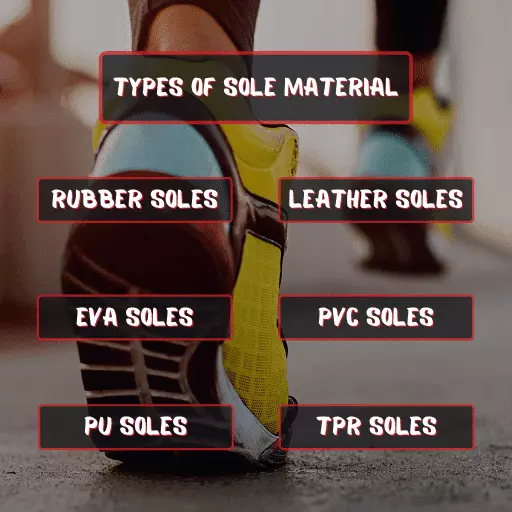
Are you thinking about buying a new pair of running shoes that aren’t too expensive, but still have a good grip and provide you enough support?
You might be also thinking about which type of sole material is best for your running shoes? You may have looked over the different types of sole materials available, but are still confused about which one is right for you? Which one can you trust?
In this guide, I will help you find which sole material is best for running shoes. I’ll also tell you the benefits of different kinds of sole materials and show you how each sole material differs from each others.
Let’s get started.
Which Sole Material Is Best For Running Shoes?

PU soles are the best shoe sole material for today’s runners. PU sole is water-resistant, breathable, and durable. It provides maximum cushion and traction as well as being able to withstand multiple surfaces from concrete, to dirt roads, to grass.
In addition to PU soles, there are other options available for runners looking for added traction and durability with EVA combined with PU soles providing shoes with maximum cushioning and excellent traction on multiple surfaces!
Why Sole Material Is So Important?

The sole of your sneaker is the bottom surface of your running shoes. It is arguably the most important part of your shoe because without a proper sole there’s no way you’ll be able to properly run.
It is what connects you and the ground and it provides the foundation for the rest of the shoe to be built on. It is also the part of the shoe that is most exposed to the elements, which means that it is impacted by everything that you run on.
The sole is the foundation of your running shoe so it needs to be both flexible enough to allow you to move with ease and also supportive enough to provide the stability that you need.
There are many combinations of sole materials that can be used to achieve these goals. It is important to know all the options before deciding on the best combination for you.
Anatomy of a Sole of Running Shoes

Soles are made up of three main components, the inner sole, midsole, and outer sole or outsole.
Insole
The insole is the top layer of the sole structure in running shoes. It acts as the mattress for your feet to rest upon while you run. The inner sole is made up of soft microfibers that are usually attached to the upper part of the midsole and are removable if damaged.
They are meant to protect your feet by absorbing shock when you run on hard surfaces. They are also meant to be comfortable and provide cushioning.
This is one of the most important components in any running shoe because it keeps your foot comfortable while running and protects it from abrasions, cuts, and blisters.
Midsole
The midsole is the part of the sole containing the majority of the cushioning. The midsole is made up of foam that is meant to be soft and pliable. It contains a lot of soft foam cushioning, which acts as both shock absorption and cushioning.
It absorbs impact from your running stride and provides you with the right amount of cushioning for different kinds of surfaces you run on. Some midsole materials are shock-absorbing while others even work at lowering the temperature in your shoes.
The midsole could be made up of different materials depending on its intended purpose like EVA foam for comfort or EVA rubber for traction and flexibility.
Outsole
The outsole is the bottom of your running shoe. The outsole acts as a shield between your feet and the road.
It provides support and traction and can be made up of different materials like TPU, rubber, PU, or other hard materials.
Some outsole materials are meant to be used on different types of surfaces. For example, TPU is used on slippery surfaces like ice and water while PU is better for hard surfaces like dirt tracks or trails.
Types Of Sole Material

The running shoe’s sole plays a very important role when it comes to running. There are basically six different types of sole material, and each of these materials has its own unique attributes. We will explore the different sole materials and how each one is different from the other.
Rubber Soles
Rubber sole materials are very sturdy. Some rubber-soled shoes will typically be heavier because they’re designed to withstand a lot of use and not wear down easily at all. They’re composed of long-lasting, impact-resistant rubber compounds with high tensile strength for maximum durability. Rubber soles are made up of a couple of different rubbers:
Natural Rubber
Natural rubber is extracted directly from rubber trees. It is a soft material that has good durability for impact resistance.
Synthetic Rubber
Synthetic rubber is a man-made product that is based on the same chemical structure as natural rubber. It has been modified to be more flexible with better resistance, heat, and cold tolerance.
Features and Benefits of Rubber Soles
Durable and Flexible: Rubber sole materials are good for different kinds of surfaces because they’re very durable and have a wide range of flexibility with a high tensile strength which allows them to keep their shape even during extreme conditions.
Traction: They have a medium amount of cushioning but most importantly they provide great traction and support for your arches when you run.
Affordable: The rubber-soled shoes are affordable because they are made of rubber, which is cheaper than leather. The high supply of shoes with rubber soles has contributed to their low price.
Various Varieties: Rubber soles come in a variety of colors. Also, they can be easily cleaned and maintained.
EVA Soles
EVA stands for ethylene-vinyl acetate. It is a material that has been used in running shoe construction for a variety of applications including outer soles, midsoles, and insoles.
EVA sole is one of the most reliable options available for running shoes because it’s got a very good combination of durability, flexibility, and cushioning at an affordable price.
Features and Benefits of EVA Soles
Comfortable: EVA soles are soft and cushiony. This makes them very comfortable for runners with different kinds of foot types.
Very Lightweight: EVA midsole provides lightweight cushioning that reduces the impact on the sole of your feet while running on different types of surfaces.
Cost-effective: The EVA soles are very cost-effective compared to the other sole options because they’re made of plastic, which is much cheaper than leather, or other materials.
Durable: EVA sole might not be as durable as rubber soles but still, it can withstand several breakages with its high tensile strength, which makes it the perfect material in the construction of a running shoe.
Versatile: They can be used in different parts of the shoe to provide support and cushioning where necessary. For example, they can be used as outsoles or midsoles. They are also an excellent option for insoles because they are soft enough to take the form of your feet while retaining their shape during use.
PU Soles (Polyurethane Soles)
What is PU Sole?
Polyurethane is a polymer that is used in the construction of running shoes. It is also suitable for use in midsoles because it gives the shoe both flexibility and cushioning.
Some polyurethane soles are made with different densities or thicknesses which have different impacts on the comfort, support, weight, and durability of the shoes.
Features and Benefits of PU Soles
Shock Absorption: PU is a shock-absorbing material. Its softness and malleability help in absorbing the shock and increasing the cushioning of the shoes.
Resistant To Heat And Cold: With the help of the insulation properties, polyurethane also allows the runner to run comfortably in different weather conditions.
Lightweight: The lightness of the polyurethane is one of its biggest strengths because it aids the runner during his/her training activities.
Flexible: No matter how thick or thin any polyurethane sole may be, it will always have flexibility on some level which is an important factor for comfort.
Eco-friendly: Polyurethane is a material that is derived from the recycling of plastic waste, which makes it eco-friendly.
Leather Soles
Leather is a natural material that is processed from animal hides. The leather sole is an excellent shoe sole because of its flexibility, durability, and traction.
Most of the leather-soled running shoes are not waterproof though so you should take extra care when wearing them in rainy conditions since water could easily seep into the material.
Leather soles are commonly used on formal shoes, running isn’t something that can be done in those shoes that have leather soles.
Features and Benefits of Leather Soles
Breathability: Leather shoes provide great breathability because of their natural origin. This allows them to stay comfortable even in hot and humid conditions.
Lightweight: A shoe with a leather sole is lighter and provides extra comfort and support that you wouldn’t get with other materials.
Eco-friendly: Unlike other materials, leather is biodegradable. It decomposes when left in the environment which makes it eco-friendly.
Very durable: The shoes with leather soles are resistant to breaking because they’re made of very hard material.
Odorless: Leather doesn’t make your feet sweat because of its breathability which makes it odor-free.
PVC Soles (Polyvinyl Chloride Soles)
Polyvinyl chloride is a type of plastic, so it’s used in many different things. It’s found in raincoats, car windows, and most importantly shoes.
PVC offers shock-absorbing properties which makes it a great option for animal-friendly alternatives of leather. Because of this, it makes the most cost-effective material out of all synthetic options of comfort and cushioning due to its ability to be molded however you want.
PVC, or polyvinyl chloride, can be great for daily wear and tear but not so great if you want to run or exercise because it doesn’t provide enough comfort that runners prefer while they are running or exercising.
TPR Soles (Thermoplastic Rubber Soles)
The TPR material provides great shock absorption and is quite breathable. This makes the shoe a pleasure to wear during any outdoor activity since it keeps your feet cool and dry at all times.
Another interesting point about these TPR soles is that they are affordable and resistant to low temperatures.
TPR soles are not as popular as other soles. TPR isn’t usually recommended for running because it’s not as comfortable and supportive as some other kinds of sole shoes out on the market.
Frequently Asked Questions (FAQs)

Conclusion
Any runner would love to have shoes that provide great support, cushioning, and durability while also providing them with adequate comfort throughout the day.
Picking the right sole material is important because you don’t want to end up with a pair of shoes that will hinder your running performance.
While there are many alternatives for sole you can choose from, EVA and PU soles are considered to be the most popular and durable materials for running shoes among runners.
Thanks for reading our guide on sole materials, I hope that it will help you make the right decision when choosing the best shoe for your running needs.
If you have any more questions on this topic then let us know in the comments below.
Related Posts:
- Top 7 Best Nike Running Shoes In India
- Top 10 Best Shoes For Running Under 4000 Rupees
- Best Running Shoes Under Rs. 3000
- 10 Best & Affordable Running Shoes Under 1500 Rupees
- Best Running Shoes Under Rs. 1000 In India
- Top 10 Cheapest Shoes For Running Under 500 Rupees
By Neha Saxena
I'm a writer and researcher for Shoes Suggester. A few years back I was overweight but now I’ve got my weight under control with the help of running! In the process, I’ve tried on countless pairs of shoes from walking shoes and running shoes to flip flops and even boots! It's been a great journey so far.

Thank you for this information it has been very helpful to me in looking for sports trainers, and all the pros and cons of each sole.